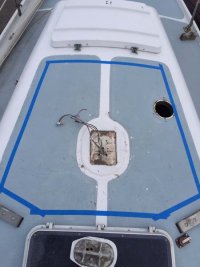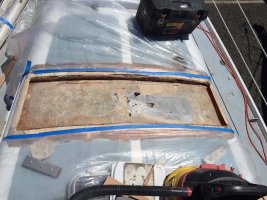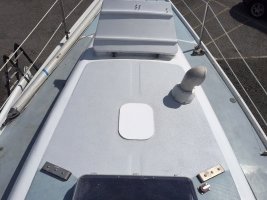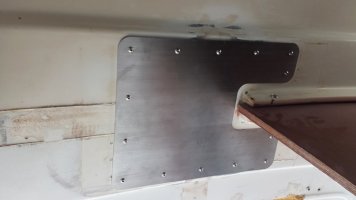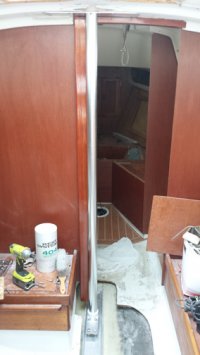tenders
Innocent Bystander
E32 mast step deck repair: an illustrated guide
My 1969 Ericson 32, which I've owned since 1991, has a deck-stepped mast. Under the mast, just a bit to port of the centerline, is a mahogany compression post, and about 18” to the right of this is another mahogany post of somewhat less significance, as it is well offset from the mast.
Over the years the area in the cabin overhead between these two posts has gradually sagged, cracked, and leaked a few drops of water through the cracks. Outside on deck there was no perceptible deflection and no sign of a soggy/hollow core, as has affected some other areas of the deck. Last year I jacked up the overhead and slipped a piece of quarter-inch G10 between the compression posts to try to add some additional support; it sagged, too. This year I decided to bite the bullet and solve the problem. I have a drawing from what I think is a later run of Ericson 32s which was helpful, though not completely accurate, as a hint to what lay beneath the fiberglass.
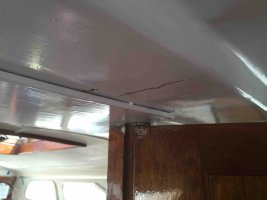

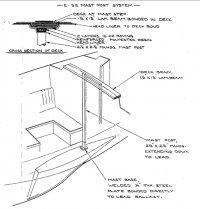
Last weekend my boat partner and I cut out a 4’ x 18” slab of deck under the mast, along the entire width of the cabin top, and found the culprit: a nearly 2”-thick beam of completely soggy plywood, slightly bent to accommodate the arch of the cabin top, and likely made wet from 46 years of rainwater sneaking into the mast and creeping along the channel drilled into the wood directly under the mast for the mast lights and electronics. It isn’t rotten but it’s close: the plies are delaminated, and seem to peel apart relatively easily with a wide chisel and a hammer. The rest of the deck fore and aft of this chunk is balsa core, insulated from the beam by quarter-inch dams of resin running the length of the plywood along the margin. This balsa looks as sound as the day it was put in, so the problem is really isolated to this 4’ x 18” x 2” plywood beam.
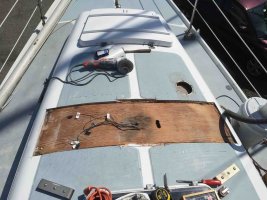
The question: how best to replace the plywood? I have a few ideas and was wondering what the real experts here might think. Each of my core repair ideas involves finishing the deck with a layer of quarter-inch G10 on top, painted to match the rest of the deck, and refabricating the slightly-elevated mast step with another pice of G10. That’s the easy part; I've done that before.
Option 1: Plywood
Laminating in 6-8 layers of quarter-inch marine plywood, with a thick coat of epoxy between them, weighing each layer down to conform to the arch of the deck, would be straightforward and inexpensive. The problem: waterlogged plywood created the original problem, and I don't want to be worrying about the effects of water incursion again. Also, the sag has been present for years, would replacement plywood be strong enough? [EDIT: this is pretty much what I ended up doing...but fit less plywood in there and a lot more epoxy/fiberglass layers than I initially thought.]
Option 2: Plywood/fiberglass roving sandwich
Alternating layers of thick roving and quarter-inch plywood, again weighing down the plywood so it conforms to the arch, would also be straightforward and inexpensive. But again, will this be strong enough?
Option 3: Plywood/fiberglass roving sandwich, with G10 beam spanning the compression posts
I could place a beam of half-inch G10 across the two compression posts, and fill in the remaining space with plywood/glass laminate layers. I’m concerned this will make the G10 under the mast, if it isn't perfectly level, act as a lever and lift up the deck at the worst possible time.
Option 4: Plywood/fiberglass roving/G10 sandwich
A layer, or even two, of half-inch G10 could be glassed in across the deck, filled in with layers of roving and/or plywood. The trick is to maintain the deck arch. Perhaps this could be accommodated with side tabs of G10 (pieces 1 and 3 in the last drawing) glassed onto the ends of a main G10 beam (piece 2 in the drawing) spanning both compression posts to starboard, and extending to port to offset the “lever” effect. This would be very strong, I think, and the high cost of the thick G10 would be offset a bit by less lamination being necessary.
How crazy are these ideas? I’m leaning towards Option 4.

My 1969 Ericson 32, which I've owned since 1991, has a deck-stepped mast. Under the mast, just a bit to port of the centerline, is a mahogany compression post, and about 18” to the right of this is another mahogany post of somewhat less significance, as it is well offset from the mast.
Over the years the area in the cabin overhead between these two posts has gradually sagged, cracked, and leaked a few drops of water through the cracks. Outside on deck there was no perceptible deflection and no sign of a soggy/hollow core, as has affected some other areas of the deck. Last year I jacked up the overhead and slipped a piece of quarter-inch G10 between the compression posts to try to add some additional support; it sagged, too. This year I decided to bite the bullet and solve the problem. I have a drawing from what I think is a later run of Ericson 32s which was helpful, though not completely accurate, as a hint to what lay beneath the fiberglass.



Last weekend my boat partner and I cut out a 4’ x 18” slab of deck under the mast, along the entire width of the cabin top, and found the culprit: a nearly 2”-thick beam of completely soggy plywood, slightly bent to accommodate the arch of the cabin top, and likely made wet from 46 years of rainwater sneaking into the mast and creeping along the channel drilled into the wood directly under the mast for the mast lights and electronics. It isn’t rotten but it’s close: the plies are delaminated, and seem to peel apart relatively easily with a wide chisel and a hammer. The rest of the deck fore and aft of this chunk is balsa core, insulated from the beam by quarter-inch dams of resin running the length of the plywood along the margin. This balsa looks as sound as the day it was put in, so the problem is really isolated to this 4’ x 18” x 2” plywood beam.

The question: how best to replace the plywood? I have a few ideas and was wondering what the real experts here might think. Each of my core repair ideas involves finishing the deck with a layer of quarter-inch G10 on top, painted to match the rest of the deck, and refabricating the slightly-elevated mast step with another pice of G10. That’s the easy part; I've done that before.
Option 1: Plywood
Laminating in 6-8 layers of quarter-inch marine plywood, with a thick coat of epoxy between them, weighing each layer down to conform to the arch of the deck, would be straightforward and inexpensive. The problem: waterlogged plywood created the original problem, and I don't want to be worrying about the effects of water incursion again. Also, the sag has been present for years, would replacement plywood be strong enough? [EDIT: this is pretty much what I ended up doing...but fit less plywood in there and a lot more epoxy/fiberglass layers than I initially thought.]
Option 2: Plywood/fiberglass roving sandwich
Alternating layers of thick roving and quarter-inch plywood, again weighing down the plywood so it conforms to the arch, would also be straightforward and inexpensive. But again, will this be strong enough?
Option 3: Plywood/fiberglass roving sandwich, with G10 beam spanning the compression posts
I could place a beam of half-inch G10 across the two compression posts, and fill in the remaining space with plywood/glass laminate layers. I’m concerned this will make the G10 under the mast, if it isn't perfectly level, act as a lever and lift up the deck at the worst possible time.
Option 4: Plywood/fiberglass roving/G10 sandwich
A layer, or even two, of half-inch G10 could be glassed in across the deck, filled in with layers of roving and/or plywood. The trick is to maintain the deck arch. Perhaps this could be accommodated with side tabs of G10 (pieces 1 and 3 in the last drawing) glassed onto the ends of a main G10 beam (piece 2 in the drawing) spanning both compression posts to starboard, and extending to port to offset the “lever” effect. This would be very strong, I think, and the high cost of the thick G10 would be offset a bit by less lamination being necessary.
How crazy are these ideas? I’m leaning towards Option 4.

Last edited:

